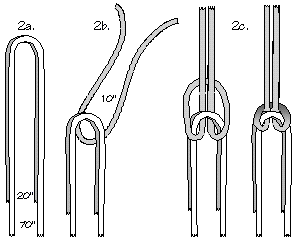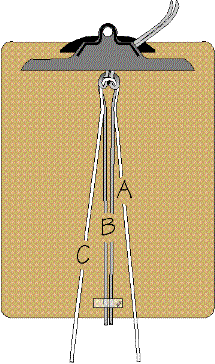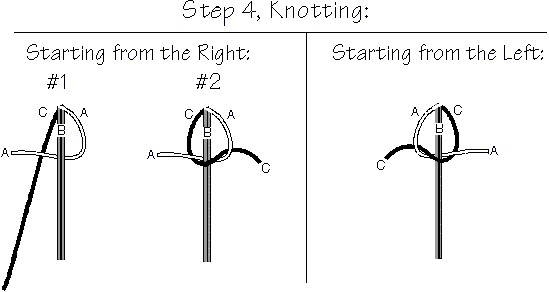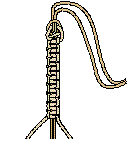How to Macramé a Hemp Bracelet — (Project #68-002-10)
Welcome to the project archives at www.rings-things.com. You might want to see the newer version of this project on our blog.
Suggested Parts: |
|
| 100" | 1mm-diameter hemp cord |
| 5-8 | glass roller beads, or any beads with at least a 2mm large hole, such as these fun color-changing Mirage Beads |
| 1 | Button with shank (or a 10mm bead with about a 3mm large hole) for the clasp |
General hint regarding cord length for macramé projects:
Start with about 10 times the finished length of the project. For example: This project is about 8 inches long. We estimated another 2 inches for knots, so our base measurement is 10 inches. 10 inches x 10 = 100 inches (total cord needed). We’re using a double central (filler) cord, so double the base measurement (2 x 10 inches) to give us a 20 inch center (filler) cord. Also needed is a 10" piece for the adjustable clasp. This leaves 70", plenty for the remaining (knotting) cord. The more knots in a project, the more cord used; the more beads used, the less cord needed.Tools:
- Scissors or clippers
- Tape (masking tape works well)
- Optional: A clipboard makes your project portable
Instructions:
- Cut cord into the following pieces:
One 10-inch piece
One 20-inch piece
This leaves a remaining piece about 70 inches. - Connect cords:
- Find centers of the 20-inch and 70-inch pieces of cord. Place the two centers (loops) of each
cord on top of one another and leave all four ends dangling free. - Find center of the 10-inch piece of cord.
- String the centers (loops) of the two cords into the the center of the 10-inch piece. Bring all four
loose ends back through the center loops and pull tight. This knot is a half hitch. - Make sure cording is even and all ends still match up.

- Anchor the project. This helps keep track of what step to do next, and secures the project in place. A clipboard works well and allows for movement and storage of an unfinished piece. Secure the 10-inch piece of cord under the clip and let the long pieces of cording dangle. Tape the short pieces at the bottom of the board. Taping the whole project to a table will do the same thing as a clipboard, but is not as convenient if you want to move your project.
- Start knotting:
This bracelet uses one basic knot, the half knot. To create a half-knot, follow the diagram below, in which the long (knotting) cord on the right side will be "A," the two short (filler) cords in the middle will be "B" and the long (knotting) cord on the left side will be "C": - Start with cord A and bring behind cords B, forming a loop with the A cord (about the size of a
50-cent piece) out to the right side. - Now bring cord C behind the long length of A (now on the left side) and over cords B. Pull through
the loop of cord A. - Pull tight. Hint: The tighter the cord is pulled, the smaller the knot will be. Find the desired size
and pull at that tightness throughout the project for consistency. - Repeat step 4, but this time start on the left side instead of the right.
- Alternate sides (one knot starting from the left, the next knot starting from the right) for approximately 20 knots. Be sure to create an even number of knots. Pull knots consistently snugly. Hint: keep track of which side you are working on. After a knot is pulled tight, notice that the side to be worked on next is the side with the cord facing forward, not the cord facing the back.
- Add beads:
- Slide a bead over cords B (the fillers), and push it up close to the last knot (but don’t bunch up
the knots). If the bead is difficult to slide over the cord, twist the bead as you push it on. - Go around the beads with cords A and C. Then make a knot as usual with cord A (starting on the
right side, assuming your last knot before adding the bead started on the left). - Push knot up to the bottom of the bead.
- Add 3 more knots (left, right, left).
- Add at least two more beads the same way (adding 4 knots after each bead). When you add your
third bead, test the length (on your wrist or ankle). Does it go about half way around? If yes, then
this is the middle —only add two more beads. If no, then continue adding beads (with 4 knots
after each bead). If you add more than 8 beads, you bead pattern will probably be off-center. Don't
worry if it seems like the project won't be long enough. That piece of cord hanging back at the
beginning makes this project any desired length between 6 inches and 12 inches. - After adding your last bead, make about another 20 knots (the same number you made at the beginning).
- Make the clasp:
- After design is finished, slide the 10mm pony bead onto all 4 cords. Pull snug and tie a knot.
This bead will go through a loop made on the opposite side. - Trim cords and apply a drop of glue to secure the knot.
- Measure bracelet on wrist (or anklet on ankle) to find the desired length needed.
- On the opposite side of the bracelet (the 10 inch length of cording) tie a knot at desired length.
About ¾ of an inch past that knot, tie another knot. - Trim excess cord and apply a drop of glue to secure the knots.





See More Free Tutorials in our Design Gallery